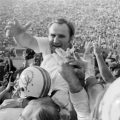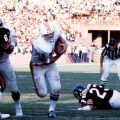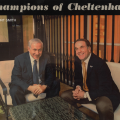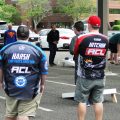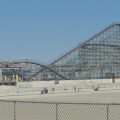NASCAR
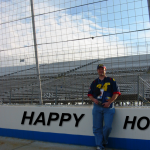
Solving NASCAR’s Racetrack Problem, Part 2 – Happy Hour Motor Speedway
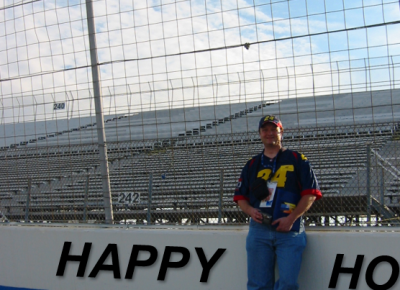
While writing for the Frontstretch years ago, I came up with a bunch of ideas for a new track that would revolutionize NASCAR racing. This piece originally appeared here, and they’ve given me permission to reprint it, since the ideas truly are innovative and should be implemented! Enjoy.
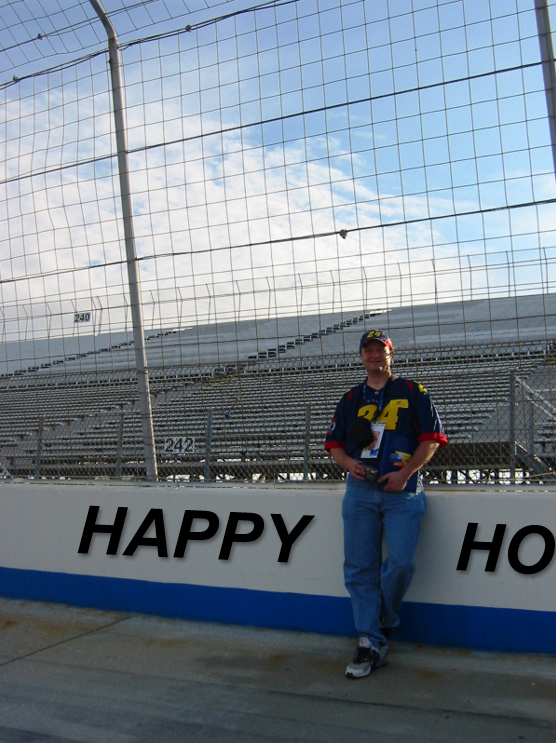
Official Columnist of NASCAR Kurt Smith, at the brand new speedway he helped design. (“Happy Ho”…I crack myself up…)
Solving NASCAR’s Racetrack Problem, Part 2 –
Happy Hour Motor Speedway – A New Short Track
In last week’s Happy Hour, I discussed baseball’s ballpark boom and how the place responsible for it all, Oriole Park at Camden Yards, changed the formula for modern ballparks—from antiseptic concrete bowls to eye-catching and distinctive structures with natural grass. I suggested that NASCAR could learn from this, with most of the NASCAR schedule littered with tracks that are all too similar to one another.
My idea was that the architects of the next speedway could try the same tactic, and use elements of several classic speedways in its design, while at the same time incorporating the modern amenities that the newer tracks brag about. And the next time NASCAR moves to a new track, it has a place to go to with better racing and a memorable fan experience. And new tracks in the future have a standard.
With that in mind, here is what defines Happy Hour Motor Speedway I. Feel free to chew me out if something doesn’t work, or add any ideas of your own.
It is eight-tenths of a mile (just slightly longer than Richmond). I have no beef with the biggest of big tracks—I’m in the minority in finding Pocono’s pure size endearing—but let’s face it, all of us love to see drivers fighting for the tiniest of tiny bits of real estate, and to see drivers almost half a lap down when the race starts. Bristol and Martinsville, more than most tracks, separate the men from the boys in this sport. My track will be a little bigger but not by much. There will be carnage, but I’m leaving the crown of most carnage to Bristol where it duly belongs. And like Richmond, it will be plenty wide enough for three-wide racing.
I’m not one of the fans that need to see tempers in full bloom every week, and I’m not one who tunes in for wrecks either. But for my first track, I’m going with short, because this is where many of the drivers find their roots. It’s not that drivers don’t need a good racecar for less than a mile, but they do have to be up on the wheel throughout. No lapses in concentration allowed. My track is going to be challenging to race on, but drivers will love it.
My second track will be huge. It’s going to be the longest in NASCAR. But the current car NASCAR has steadfastly insisted we use runs far better at short tracks at the moment, so we’re starting off with flying fighter jets in a gymnasium.
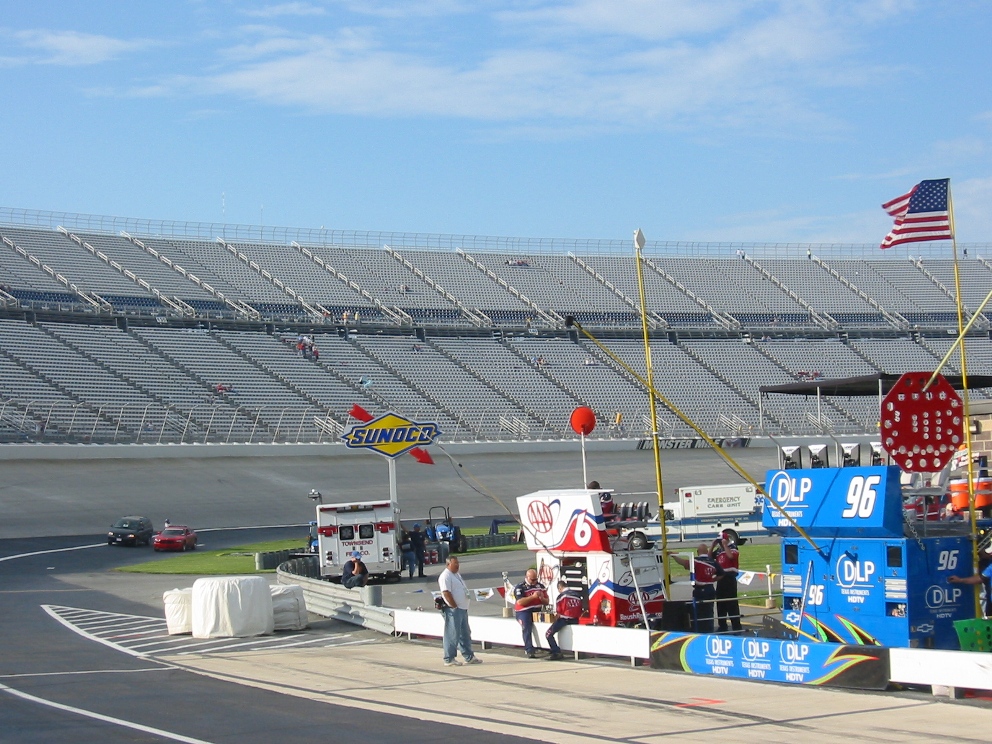
The Monster Mile, made monstrous with high banking.
There is high and progressive banking all around the track (like Dover). Martinsville is great partly for its almost nonexistent banking. A driver scrambling to slow to 30 MPH into a turn is great. But we want to see guys going fast. At HHMS they’re going to barrel into corners going at least 110. I’m estimating somewhere between 20-25 degrees of banking in the turns.
The banking is going to be different on the opposite ends—higher in one and two than in three and four or vice versa. It might not be as high as Dover’s nine degrees on the straightaways, but there will be some, maybe six degrees, because that improves the fans’ view too. More on all that in a minute.
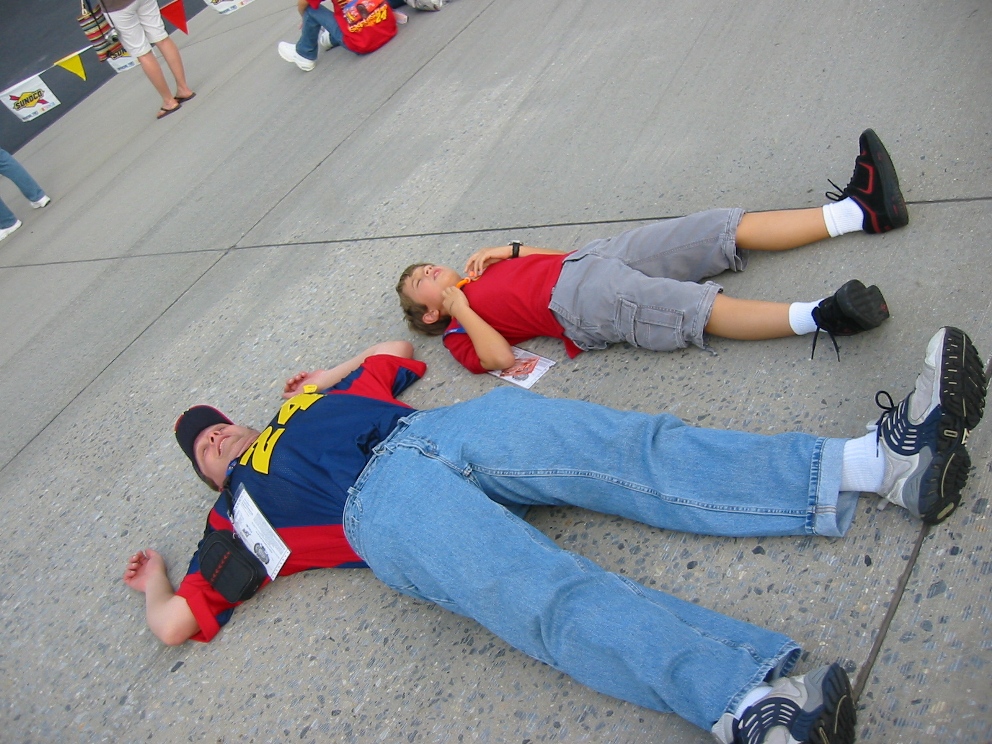
No, concrete isn’t more comfortable to lie on.
The racing surface is concrete (like Dover and Bristol). This isn’t because I like Carl Edwards. Or even because I think racing is better on concrete—truthfully I can’t really tell, although concrete is harder on tires and cars run faster on it. It’s just to be different, to require a different type of setup, and to make crew chiefs do some thinking.
And it looks neat. Pieces of black tires that were insufficient to the task of staying intact will be in full view in the off-white background, strewn about the racetrack until it rains.
There are no seats on the backstretch (like Pocono and others). The seats at HHMS will be from the middle of turns three and four and the middle of turns one and two, for several reasons.
First, not having the track completely surrounded by seats is easier on fans’ eardrums. I have enjoyed races at Pocono without the benefit of earplugs. There is no way that’s happening at Martinsville.
Second, the seating should be arranged so that everyone in attendance can see pit road, like at Pocono. Often that is where some of the best action takes place—seeing a leader suddenly have to come in, seeing phenomenal pit crews accomplish in 15 seconds what takes Firestone a day, seeing cars race at 35 MPH to be the first out. No one who pays for a ticket should miss that.
Third, I like the idea of not having subpar seats anywhere at my speedway.
And lastly it’s good for aesthetic reasons too…I like looking at wide open expanse. No racetrack, no outdoor sports venue for that matter, should isolate itself from its surroundings. One should know where one is not by looking at the sign on the scoreboard but by looking at the meadow or RV park or lake or railroad beyond the site of the track. The view should be interesting, sure, just trees wouldn’t be great, but that’s all part of picking a great location. That’s next.
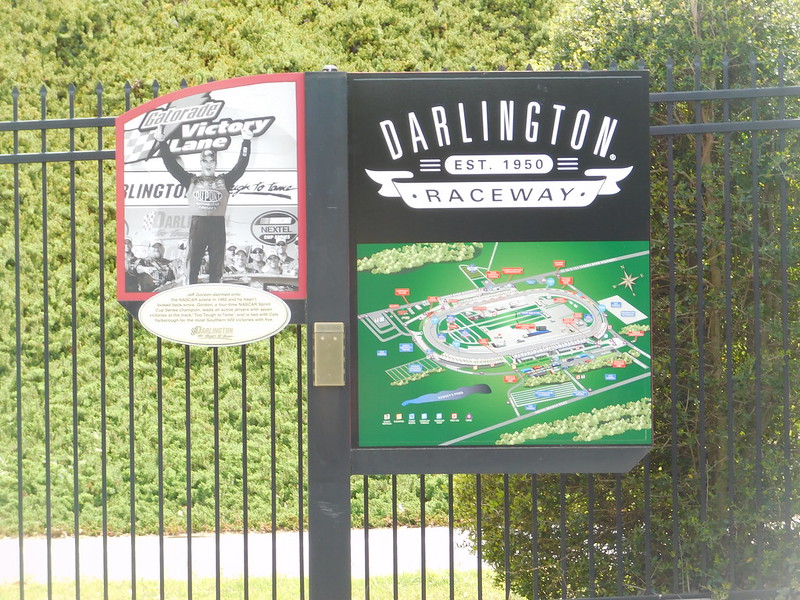
Darlington, built when land for speedways was harder to come by.
(photo courtesy of Adam Moss on flickr (CC-BY-SA-4.0).)
It is located near a body of water and a railroad, which influences its design (like Darlington). Asymmetry…where on earth has that concept gone in racing? Hasn’t anyone noticed what makes Darlington so special? Irregularity based on location is one of the features that define the new ballparks. It’s hard to believe that so few of the tracks in NASCAR have any asymmetrical quirks. I guess Phoenix, Pocono, and the road courses count, but there isn’t much else.
Not only would there be no seats on the backstretch, there would be a local ordinance reason for it, even if it is fudged a bit (as some new ballparks are—San Diego is an example). This will result in the frontstretch and backstretch being different lengths to go with the aforementioned different banking and angles in the turns. How much will the turns differ? If crew chiefs aren’t cursing the day I entered this world when they come here, I won’t be happy with it. HHMS will separate the men from the boys on the pit box too.
Since ballparks located in downtown areas of cities place more emphasis on public transportation, maybe something like that could work for races. NASCAR has far worse traffic problems at its events than most other sports. Being near a passenger railroad in a rural area could result in one or more stops on the rail to be solely for the racetrack…maybe one or two at the track itself, one at the RV park, and a couple in nearby towns where shuttles could take groups of people to the track after breakfast in a local restaurant. Fans could park and ride at several nearby locations.
Traffic is absolutely murder at most tracks on race day. HHMS will take every step to ease it. Easier said than done, I know, but we have some smart people around here.
The view from the stands should be of a local railroad as opposed to a highway. People see highways every day without thinking twice. A railroad stirs up images of hardworking men building a medium of transportation, of businesses transporting loads of raw materials—how America used to be before (ironically) the automobile. It’s nostalgic. Remember, Smith-designed speedways are about paying tribute to the sport’s place in the nation’s history.
There are no low seats, or the low seats get sold very cheaply. At nearly every track, there is too much stuff in the infield to be able to see what is going on in the backstretch from a low seat. Maybe things in the infield could be arranged so that people can see everything, but I would rather people weren’t close enough to risk hearing damage if they can’t see the whole track.
Dover’s high banking makes it possible to see most of the track from wherever one is sitting, so that is one solution, but I also think the lowest ten rows or so could be eliminated without too much pain. I’ll have plenty of higher seats, kind of like in the one odd-looking high section at Richmond. There will be fewer seats as a result of this. That’s fine. I’d rather have fewer seats and butts in all of them. A walkway and a row of concession and souvenir stands could be placed underneath the grandstand, facing pit road. It might take some soundproofing, but people also wouldn’t miss much getting a hot dog.
It is located in a rural area, with no casinos and no Oscars (like Talladega or Martinsville). The focal point of location chosen would be the racetrack. Not an industry, not another sport, the racetrack. If it works for Green Bay it can work for NASCAR. It probably should be located somewhere near a big market, but that market should be a good sports market, like Philadelphia, St. Louis or Detroit as opposed to Atlanta or Los Angeles. (No disrespect intended to fans there.)
At first my thoughts on this were that we should put a racetrack back in the south, seeing as they’ve lost so many in recent years and that is still where the base of NASCAR fans is. Perhaps somewhere in Mississippi…and networks and/or the track’s PA could play ZZ Top’s “My Head’s In Mississippi” before each race. It’d be a good counterpoint to hearing “Sweet Home Alabama” before Dega races. I’d mix the concrete for the whole track myself to see ZZ play it live there.
Sorry to have gotten off course a bit. If we’re going back to the roots with this speedway, it could be somewhere in the Southeast. We can find a way to assure Brian France that doing so isn’t an endorsement of slavery.
But on further reflection (it’s great to have a job that encourages “reflection”), I’ve decided it would be fine to go anywhere where race fans are proven to be. If that’s in California then so be it, but we now know that the Los Angeles area isn’t the place. They won’t even support football for crying out loud.
I’m not the biggest fan of Loudon, but there’s no question that the place sells tickets. Maybe the New England market could support another race on the schedule. Any locality that carries a consistently sold out Nationwide race, like Nashville or Gateway, could be considered.
It’ll take some research. But in true retro style, we’ll go where fans already are, not where NASCAR would like them to be.
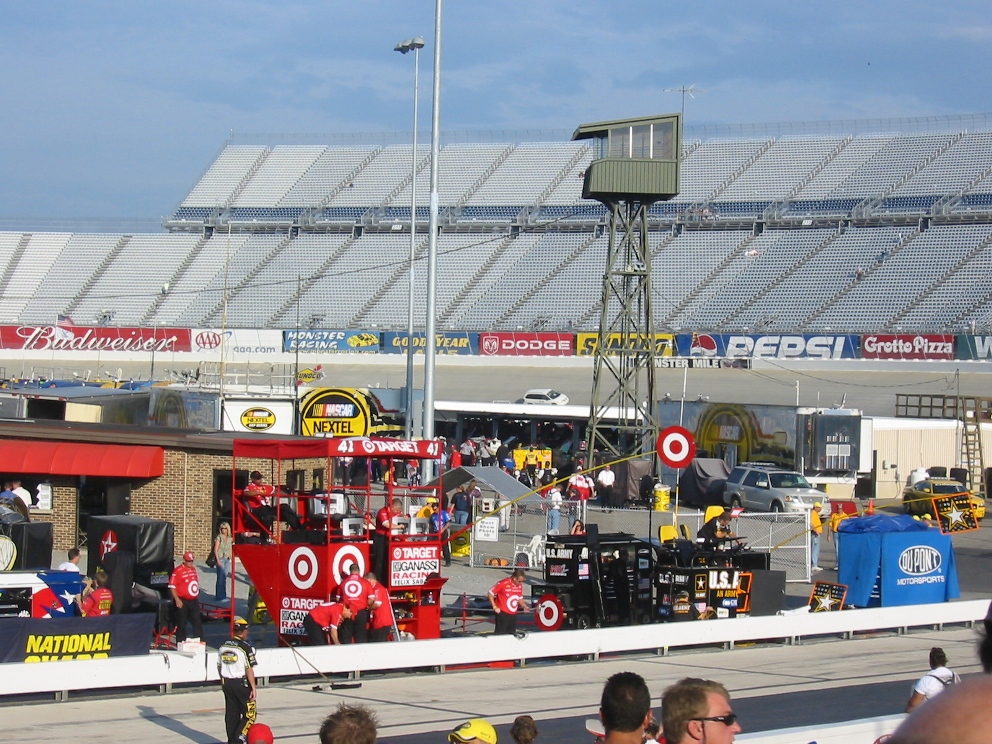
Racing on Sunday afternoon, the way God intended.
There are no lights! (like Pocono, Kansas, Dover and Wrigley Field once). I exclamation pointed this for a reason. This season’s Daytona 500 convinced me more than ever that races should be held on Sunday afternoon. Not Saturday, not in the late afternoon/evening. Sunday Afternoon.
The green flag will drop at 1PM and we’ll race for 500 laps, and it’s going to take a lot of rain to deprive patrons of any of them. Networks won’t like it. Tough. Fans in attendance at HHMS will get home or back to their hotel at a decent hour.
There are seats with armrests, not benches (like Lowe’s). I will say this about Lowe’s: one doesn’t have to stop drinking beer or soda to keep their bladder from exploding, because getting up and finding one’s seat again is nowhere near as difficult than at a place with benches and rubbing cheeks. (Cheeks rubbin’ is NOT cheeks racin’.)
There is free parking and coolers are allowed. Damn straight.
There will be nods at the front gate to some of NASCAR’s greatest moments and heroes. Let’s just try a few off the top of my head: a statue of Dale Earnhardt in his famous arms-in-the-air pose after finally winning the Daytona 500. A mural of Busch and Craven at the finish line in Darlington. Replicas of Cale’s 11 and Jimmie’s 48 cars, with a sign in the middle saying “Three straight.” The prominently displayed #3 flag Jeff Gordon flew out the window at Phoenix, commemorating his tying of Dale Earnhardt’s win total. It will be eye-catching on the outside too.
There is often a wait at the front gate to let people in. Happy Hour Motor Speedway would entertain fans by featuring large screens at the front gate, showing ongoing video broadcasts from some of the greatest finishes: the 1976, 1979 and 2007 500s, Harvick and Gordon at Atlanta, Earnhardt slicing through the field at Dega, and many, many others. People waiting will get pumped thinking about what they are about to witness. They’ll get so into it they won’t mind the line. Maybe we could strike a deal with the NASCAR Images people. They do an amazing job.
And a huge picture of Brian France with a circle and a line through it. (OK, that last won’t help my quest to get a Cup race at my speedway, but I can dream.)
There would be an award for winning a race (like Martinsville’s grandfather clock or Nashville’s Gibson Les Paul). This is a relatively inexpensive gimmick that can help to make a speedway noteworthy. Most places offer a trophy. HHMS will offer something else, like a Jeff Dunham talking Peanut doll. As hard as those things are to get, drivers will be fighting that much harder for the win. Maybe Jeff himself can present the award.
There is a notable food item at the concession stands (like Martinsville’s hot dog). Is there a sports venue anywhere that serves decent nachos with real cheese instead of that Velveeta processed crap? HHMS will sell the best nachos on the circuit—served with real shredded cheddar and Monterey jack (and make sure it’s real Monterey, Jack!) cheese and kick-ass guacamole. Or soft pretzels from the Mart Pretzel Bakery in Cinnaminson (which are almost worth paying New Jersey property taxes to be near).
Whatever works. Maybe we’ll have a contest with locals bringing their finest recipes for finger foods, and the winner will have the food item named after them at HHMS. Sports fans love to munch when they’re watching. HHMS will offer a grub item that people will mention when they talk about a trip to the speedway.
And last but sure as heck not least…
It would have a great nickname. Like The Cuss Oval, or Concrete Hell. Something at least as cool as the Lady In Black, Thunder Valley or The Monster Mile. Not something lame like the Beast of the Southeast.
There you have it…the key elements of a new, classic-yet-modern short track speedway for NASCAR racing. Some time soon, I’ll present my design for a superspeedway where a restrictor plate will not be necessary.
I’m not saying any of this would be easy to do, of course. You’d meet a lot of resistance if you suggested fewer seats instead of more. And NASCAR and the networks in their finite wisdom might not like the idea of giving a race to a track without lights. As I said a week ago, a lot of folks running the show don’t think like fans.
But wouldn’t all of this be better than another symmetrical 1.5-miler?
Photo credit: Yzukerman on Best Running / CC BY
Photo credit: davidwilson1949 on Best Running / CC BY
Photo credit: Roadgeek Adam on Best Running / CC BY-SA
Photo credit: sun dazed on Best Running / CC BY-SA
Photo credit: chayes2014_ on Best Running / CC BY-SA
Photo credit: chaddavis.photography on Best Running / CC BY-SA
Photo credit: ChevyGuy454 on Best Running / CC BY-ND
Photo credit: formulanone on Best Running / CC BY-SA
Photo credit: Zach Catanzareti Photo on Best Running / CC BY-SA
Photo credit: wuestenigel on Best Running / CC BY
Photo credit: PDA.PHOTO on Best Running / CC BY-ND
The Curse of The UPS Car
While I was providing thoughtful NASCAR commentary for the Frontstretch, I noticed an interesting phenomenon about UPS-sponsored cars…that drivers either suffered significant decline with the UPS logo their car, or improved dramatically after it was gone. I detailed the whole curious anomaly in the article below, which first appeared on the Frontstretch in September of 2009.
Occasionally you hear comical stories of superstition in motorsports.
Joe Weatherly, whose untimely death in a crash is why stock cars have window nets today, suffered from triskaidekaphobia and once asked NASCAR to call the 13th Southern 500 the “12th Renewal of the Southern 500”. He also once asked to rename his 13th starting position in a race to “12a”.
There are green car phobias, which supposedly traces back to one of the Chevrolet brothers, Gaston, being killed in a Beverly Hills race. Gaston was driving a green car at the time and green has ever since been seen as bad luck, despite Bobby Labonte’s 2000 championship in an Interstate Batteries car.
Junior Johnson and Dale Earnhardt Sr. were both famous for their aversion to peanuts in the garage, and both were the targets of peanut-related practical jokes by team members and fellow competitors. One story told by Robert Yates describes a Johnson crew member painting foam packing peanuts and pretending to eat them near Johnson’s car, which sent Junior through the roof. “He didn’t think that was very funny”, chuckled Yates.
But who knows? Kevin Harvick claimed to lose an engine on a day where there were peanuts around the garage. Sometimes these things do take a life of their own.
With David Ragan pulling the UPS #6 into the Loudon garage after finishing 33rd and 13 laps down, placing him currently 30th in the standings, it’s nearly been forgotten that Ragan was seen as a driver with a bright future not very long ago, when AAA was sponsoring the car.
And it seems that there is some sort of whammy on any car that sports the famous UPS logo. Not anything dangerous, just something that makes racecars slow.
If your racing fan days go back a stretch, you remember how dominant Dale Jarrett once was, as difficult as that may be to believe seeing his last few seasons.
In 1996, Jarrett took over the Quality Car Ford Motor Credit No. 88 for Yates Racing. In that car he won two Daytona 500s, a Coca-Cola 600, and the Winston Cup championship in 1999, after falling 14 points short to Jeff Gordon in 1997. He won 20 races, scored 95 top fives, and 119 top tens in 167 races. That is rare supremacy in this sport.
Then Jarrett and Yates signed on with UPS, launching the now-famous “Race The Truck” campaign. For two years there was a slight downturn: six wins, 22 top fives and 37 top tens, and a fifth and ninth place finish in the standings. That’s hardly terrible in any two seasons, but it was the first noticeable decline in the performance of the No. 88.
Then in 2003, Jarrett fell off a cliff and never fully recovered. He won just one race and that win was his only top five in a season where Jarrett inexplicably finished 27th in points. For the rest of his career at Yates, Jarrett would score only one more win in three seasons and never again finished higher than 15th in the standings.
Despite the drop-off, UPS was happy enough with Jarrett as their spokesman to go along with him to Michael Waltrip Racing in 2007. In retrospect that seems like a giant blunder, but at the time most of the pundits saw the big name sponsors and manufacturer and the veteran’s three car team and predicted big things.
It didn’t work out that way. Jarrett burned his six champion provisionals very early in the season and made just 24 races in 2007, never once finishing in the top ten. At the end of the season, Jarrett finally tired of the aero disadvantages of racing in a parcel delivery truck and announced his retirement after five races in 2008. In those five races his highest finish was a 16th at Daytona.
The UPS hex then fell on David Reutimann. After a 2007 season where Reutimann was the top performer at MWR, Reutimann scored just four top tens in 2008, finally exhausting UPS’s patience despite their own role in driver declines. He still had the best results at MWR, but that wasn’t saying much.
After UPS left, with the much faster Aaron’s logo back on his car, Reutimann not only won his first ever Cup race at Charlotte, but he surprised everyone by challenging for a Chase spot well into the season. Reutimann has scored five top fives in 2009, after managing zero with the heavy UPS logo on the car. As I wrote this, he was also ahead of Dale Earnhardt Jr. and Kevin Harvick in the standings, two drivers that had little trouble acquiring sponsors in their careers. And 13 drivers separated him and the UPS driver.
UPS signed on with David Ragan starting in the 2009 season. In 2008 Ragan, with AAA on the car, seemed to have the best future of the younger drivers. He barely missed the Chase and finished 13th in points, a great improvement over finishing 23rd in 2007. He scored six top fives and 14 top tens in 2008 after scoring two top fives and three top tens in 2007. He had even scored 11th and 13th place finishes at Martinsville, a place where he had once been called a “dart without feathers” by Tony Stewart. Of course it seemed like a wise choice, if you didn’t consider the withering effect that UPS brown had on past drivers.
With the UPS logo on his car, Ragan went from riches to rags. The No. 6 has exactly one top ten this season, in the rain-shortened Daytona 500. Since then Ragan has finished in the top 15 just four times, never higher than 12th. His last three races have been three straight 33rds.
And he is 30th in the standings—if he drops one more position, it will be the same margin of decline that Jarrett suffered from 2002 to 2003.
It may be a strange statistic to look at, but what would be the odds of two different drivers, driving for two different teams, dropping 18 positions in the standings in one season while sharing only a sponsor in common? (And a manufacturer, I suppose, but many more drivers have driven Fords than have for UPS.)
Most all of this can probably be explained away without superstition. Yates in general was beginning a decline when they signed on with UPS. All of Michael Waltrip’s teams have struggled mightily. Roush Fenway has had problems with NASCAR no longer allowing them to test. You could just call it poor timing and foresight on UPS’s part.
But there isn’t any denying a noticeable correlation between a team’s performance with and without a brown UPS logo on a racecar. UPS appeared on Dale Jarrett’s car and he went from contending for titles to fighting to make races every week in just a few years. They appeared on David Reutimann’s car and Reutimann showed little improvement, then after their departure he rocketed to near playoff contention. UPS attached its logo to David Ragan’s car and he has gone from a young driver with a bright future to being one of those drivers who is rarely shown on TV unless he crashes or enters the pits backwards.
No doubt Matt Kenseth breathed a sigh of relief when UPS refused to replace DeWalt on the No. 17.
Did this post make your day a little bit?
I hope so. If it did, I would really appreciate your support.
When you use this link to shop on Amazon, you’ll help subsidize this great website…at no extra charge to you.
Thanks very much…come back soon!
Photo credit: rmkoske on VisualHunt / CC BY-SA
Photo credit: Darryl W. Moran Photography on VisualHunt / CC BY-ND
Photo credit: Dei3Nascar8 on Visual hunt / CC BY
Photo credit: The Freewheeling Daredevil on VisualHunt.com / CC BY
Photo credit: Hans J E on VisualHunt.com / CC BY-SA
Photo credit: pocketwiley on Visualhunt.com / CC BY
What Caused The Decline of NASCAR? A Former Reporter’s Thoughts
In the early 2000s, NASCAR was soaring. It may be difficult for younger people to imagine it, but the sport was once poised to overtake the NFL in popularity. Yes, that’s actually true; read it again if you need to. So what caused the decline of NASCAR to the point where the sport is desperately trying to remain relevant?
I covered NASCAR for six seasons for two excellent racing websites, That’s Racin’ (the Charlotte Observer’s racing site) and the Frontstretch. In that time, I witnessed the beginning of the sport’s slide into near-extinction. I’m also someone who became a disenchanted former fan myself.
Having followed the sport in the time frame when it began, I can offer what I believe are the real reasons for the decline of NASCAR. I can also dispute other reasons for it that I see being offered today. This is all just ultimately my opinion, but it’s a carefully considered one.
I’ll start with a few things that I don’t believe caused the decline of NASCAR, then I’ll share what I think really did.
The Decline of NASCAR, Non-Reason #1: The Cars Are Too Spec
I’ll submit that this is a reason a few fans I know stopped watching the sport. In NASCAR’s pre-1990s heyday, when it was still very much a regional sport, manufacturer identity was a big thing. People rooted for car brands as well as drivers, and car companies believed in the whole “win on Sunday, sell on Monday” mantra.
However, by the time NASCAR was peaking in the early 2000s, there already wasn’t much manufacturer identity left. The cars already were mostly spec at that point, and the sport was doing just fine…booming even. The decline of NASCAR from dominance started circa 2005, and there wasn’t any big change to car specs in that time period.
All that said, the unveiling of the “Car of Tomorrow” in 2007 certainly didn’t help. It was boxy, ugly, and top heavy…and its shape was part of the reason for the Indianapolis debacle of 2008. In that race, caution flags were flown almost every ten laps for tire wear, as Jimmie Johnson limped to a victory. The fan backlash was loud and intense. If any single event hastened the decline of NASCAR, it was Indy 2008.
But in a relatively short time, NASCAR corrected the car and the multiple issues with its design, and while the cars don’t differ by manufacturer like they once did, at least we’re not seeing disastrously awful races just because of the car’s construction. In fact, the current car lends itself to some pretty good racing.
Lack of manufacturer identity may have been a reason some hardcore fans left the sport in the early 1990s, but that doesn’t seem to me to be a valid reason for the sport’s popularity plunge since 2005.
The Decline of NASCAR, Non-Reason #2: It’s Gotten Too Safe
I’m not sure why people would think this, although I’d actually had some heated debates with Tom Bowles at the Frontstretch about it. Bowlesy thinks there needs to be an element of risk for racing to be exciting; I don’t tune in to races to see a car potentially fly into a catch fence and injure spectators.
NASCAR did (and still does) market the possibility of spectacular wrecks. I’ll never forget seeing Elliott Sadler’s terrifying end-over-end crash at Talladega in 2003 – and seeing it again in every single ad for Talladega races for the next 3-4 years. Maybe there is a segment of fans who tune in for death-defying calamities, but that has always been a part of the sport and still is.
I can’t imagine any fan of Dale Earnhardt Sr.…and there were a lot of them…not wanting to see the sport take every measure it could to keep drivers safe after Daytona 2001. This isn’t to say that the initial Car of Tomorrow wasn’t a disaster…it was…but at the time, fans were plenty vocal about safety after the loss of the sport’s biggest icon.
For any fan that needs racing to be dangerous, there are still four restrictor plate races on the schedule. But plate racing still sucks…not only do plates produce multi-car crashes every event, they pervert the standings because of it.
I’m not buying the “it’s too safe” bit as a cause for the decline of NASCAR. Racing is still pretty danged dangerous. Just because no one has been killed at the Cup level since Earnhardt’s death doesn’t make it less so.
The Decline of NASCAR, Possible Reason #1: Jimmie Johnson’s Winning
Jimmie Johnson was a hallmark of ruthless efficiency in his prime, winning seven titles and five in a row. With his brilliant head wrench Chad Knaus on the pit box, the #48 team for years remorselessly laid the field to waste when playoff time started.
Jimmie won a lot. Which meant that other drivers didn’t win a lot. If that contributed to NASCAR’s decline, however, that is on NASCAR.
NASCAR possessed one of the greatest dynasties in the history of sports during Jimmie’s reign. Yet instead of focusing their marketing on Johnson’s unequaled supremacy, NASCAR chose to put all of their marketing eggs into the Danica Patrick basket, believing a swimsuit model who could drive a racecar would save the sport.
Danica turned out to be a huge bust…as many people who followed the sport closely, including yours truly, predicted she would be. (It wasn’t a tough call to make, if you actually looked at her results instead of her figure.)
Dynasties like Johnson’s aren’t bad for a sport…unless the sport doesn’t know how to market them. The Yankees were always good for baseball. Tiger Woods was great for golf. The Patriots’ domination was great for the NFL. People love a winner, they love to hate a winner, and they love to see a dynasty get taken down. The #48 team should have been a gold mine.
So no, Johnson’s domination wasn’t directly a factor in the decline of NASCAR – but their failure to market it most definitely was.
The Decline of NASCAR, Possible Reason #2: Dale Earnhardt Jr.’s Losing
By virtue of his father’s untimely passing, Dale Earnhardt Jr. instantly found himself with a larger fan base than any three drivers in NASCAR. As the son of one of the greatest racecar drivers in history, Junior also had an impossible standard to live up to.
But for whatever reason, Junior not only didn’t measure up to his father’s formidable reputation, he rarely even established himself as a contender. Much like Kyle Petty, he ultimately became more known for his good-guy personality and his lineage than for his achievements on the racetrack. As Junior’s fortunes continued to trend downward even while driving for the strongest team in the sport, his fan base became turned off. And he had a very large fan base.
It could be argued that Junior was the sport’s last link to its tobacco-chewing, Southern past; once Jeff Gordon tore up the sport, drivers started to appear from every corner of the country. But the sport’s most dedicated fans were (and are) still in the Southeast, and Southerners are loyal to the core to their heritage.
It’s possible that the most popular driver not performing well hurt the sport, given the sport’s fan demographic. However, like Johnson’s dominance, I doubt that this would have been as much of a problem were it not for other factors that were far more damaging.
So here are three actual reasons for the decline of NASCAR. Still with me? OK, here we go.
The Decline of NASCAR, Actual Reason #1: The Chase
One of Brian France’s very first acts as CEO of NASCAR sealed his doom as a respectable heir to a business, and nothing he did for the rest of his tenure would change that perception.
I don’t often see NASCAR’s ill-conceived playoff idea as a reason people cite for the decline of NASCAR in articles I read these days, but I promise you, that was not the case when I covered the sport. NASCAR’s initial playoff brainchild was hugely unpopular, and every griping fan in comment sections of blogs everywhere had the artificial points reset near the top of their list of complaints.
It’s not so much that the points reset NASCAR introduced in 2004 was a monumentally stupid idea. It was, but even that wasn’t the point. It was the insistent implementation of it over loud objections of fans. NASCAR polled fans about the idea on their website following the 2003 season, and fans overwhelmingly rejected it. They shut down the polls and went ahead with it anyway.
If you want to attribute the decline of NASCAR to arrogant leadership, look no further than that single act. It was blatant condescension towards what was arguably the most loyal fanbase in sports. Why poll the fans if you’re just going to ignore them?
That and it really was a stupid idea.
In case you weren’t there or don’t remember, in 2004 NASCAR welcomed their new series sponsor, Nextel (now Sprint), with a new “playoff” system called the “Chase”. After 26 of 36 races, the top ten drivers would have their points reset, putting them all on a level playing field again for the last ten races.
Yes, NASCAR actually believed an artificial points reset after two thirds of the season was the move that was going to catapult them past the NFL.
Making matters worse, within four years, the driver with the second largest fan base finished with the most points in a season twice, only to lose the title to a points reset.
It’s not often noticed, but it was definitely noticed by Jeff Gordon fans: had NASCAR not implemented the Chase, the driver of the iconic #24 could have been the one standing aside Dale Earnhardt and Richard Petty today with seven titles, instead of his protégé Jimmie Johnson. Gordon scored the most points overall of any driver in 2004, 2007, and 2014. Nothing against Jimmie Johnson for winning titles with the rules as written, but he only managed that feat twice.
Gordon wasn’t the only driver who turned in a spectacular season-long performance only to have it nullified. In 2008 Kyle Busch smoked the field for the first 26 races, winning eight of them and setting the NASCAR world on fire with his brash and unapologetic racing style. After two DNFs in the first two Chase events resulting from simple bad luck, just like that his title hopes were gone. I was critical of the Chase in plenty of columns, but I felt like I really got the point across with this one about it.
It’s largely forgotten now, because the sport’s current elimination format playoff system at least had some thought put into it. It rewards winning, which rewards fighting for wins, which creates rivalries.
But the initial “Chase”, an artificial and contrived points reset, was despised by fans. It was a radical change to a sport that didn’t need radical changes. You could say it was NASCAR’s New Coke, except Coca-Cola was smart enough to change the formula back in response to furious customer backlash.
If they hadn’t, you’d probably be reading articles today about the decline of Coca-Cola too.
The Decline of NASCAR, Actual Reason #2: The Broadcasts
I don’t need to tell anyone who was a fan in the 2000s this, but NASCAR’s broadcasts at the time may have been the worst in the history of sports. Fox Sports’s coverage was particularly abominable, with a seemingly endless parade of commercial interruptions mixed with the Ford Cutaway Car, the Home Depot Pit Crew Member, the Viagra Boner Of The Race, whatever, all during green flag racing.
Mike Joy is an outstanding announcer, and it was never a big deal for a fan to mute Darrell Waltrip’s exponentially annoying “boogity boogity boogity!” at the green flag. But it was a never ending source of irritation to see five laps of racing followed by a several minute commercial break, which was then followed by another minute of a wide angle shot of the venue and “This race is being brought to you by <several companies who also paid an obscene amount of money to NASCAR>.”
There were often times…and I’m not exaggerating this…when a viewer would see maybe five laps of racing, a two-minute break, and then just two more laps of racing before another break. Anyone who was watching then could tell you that wasn’t unusual at all.
This was a problem that actually needed to be addressed and wasn’t. NASCAR blew off fan demand for picture-in-picture commercial breaks…something they’ve since embraced…while Fox Sports’s indifference to fans went completely unchecked. It was another case of costly arrogance; as much as fans loved NASCAR, they didn’t love it enough to put up with an endlessly saturated marketing campaign featuring occasional snippets of racing each week.
One shining example was a 2010 Dover race…a “playoff” race, no less…where ESPN broke away with 11 laps to go in a very much undecided event for an ad break. Dover is a 1-mile track, and 11 laps does not take long. I remember watching it and literally wondering if I was going to see the finish of the race. I wasn’t the only one who noticed…as this blog post’s comments demonstrated.
NASCAR made an absurd amount of money with their television contracts in the 2000s, but that ultimately cost them a sizable chunk of the audience when networks were forced to make it worth their while. The broadcasts really were over-saturated with ads enough to drive fans away.
And I said all that without even bringing up that profoundly irritating cartoon gopher.
The Decline of NASCAR, Actual Reason #3: The Venues
Speaking of disrespecting your fan base, how about needlessly putting an end to a beloved 54-year tradition? That’s exactly what NASCAR did when they took the Labor Day race out of Darlington and sent it to Auto Club Speedway in California. It took quite a few years of longtime fans bitching about that, but NASCAR did finally move the Labor Day Southern 500 back to Darlington.
The move of the Labor Day race to California was part of an ongoing trend. In response to its rapidly growing popularity nationwide, NASCAR moved away from the Southeast fans who brought the sport to the dance, and began holding races in places like Vegas, Chicago and Los Angeles.
But that in itself wasn’t necessarily the crime. You couldn’t entirely blame NASCAR for no longer holding events in places like North Wilkesboro or Rockingham or even Darlington, which lost a race on the schedule for several years. The markets simply couldn’t support them anymore.
The problem was the tracks that replaced them…nearly all of them were characterless, cookie-cutter speedways where aero package ruled the day. In 1994, there were six events held at intermediate tracks of 1.5-2 miles in length. Just ten years later, there were 13 such events…nearly half the schedule.
That isn’t insignificant when it comes to explaining the decline of NASCAR. When you think of the venues that have showcased the most memorable events in the sport’s history, Daytona, Darlington, and Bristol often come to mind. Atlanta has had some classics, but that was partly by virtue of the venue hosting the championship race, such as Alan Kulwicki’s unforgettable title win in 1992.
NASCAR moved away from tracks where drivers push and shove and fight both other racecars and the track, and moved to aero-dependent speedways where engineers in the garage determined winners. As a result, teams with more resources…such as Hendrick Motorsports and Roush Racing…won big for years.
But more importantly, the racing isn’t anywhere near as exciting at the cookie cutters, as I so eloquently explained here. I also suggested a solution…that NASCAR emulate how baseball exploded in popularity after the opening of Camden Yards. Even more so than in baseball, the on-screen product is affected with the layout of a track. It makes a world of difference watching on TV.
You also don’t often see post-race fisticuffs after races at Kansas or Vegas like you might at Martinsville or Bristol. Those moments generate interest…and rivalries, which every sport needs.
Fortunately, NASCAR is finally addressing this…
How NASCAR Can Rise Again
I have reasons to believe that NASCAR can return to previous levels of popularity…maybe not on the verge of overtaking the NFL again, but at least back to a point where they have enough of a dedicated fanbase to be a solid performer in ratings and ticket sales.
Since this is a non-ideological blog, I won’t get into the things that the NFL, NBA and MLB have recently done to drive away a significant portion of their fanbases. We all know what I’m talking about. I expect that will be a boon to NASCAR’s future.
As I’ve said, the sport is finally addressing its venue problem. The 2021 campaign includes six road course races, a dirt race at Bristol (!), and a race at the concrete venue of Nashville for the first time. Labor Day is in Darlington where it belongs, and Darlington is hosting two events again. And the season will conclude at Phoenix again, a more exciting venue than Miami where the finale had been for years. There are still 11 races on “intermediate” tracks, but it’s finally moving in the right direction.
These are bold changes, but this variety of tracks will test drivers and teams at every level. No longer will teams win titles by dominating speedways; driver skill will be more of a factor, as it should be.
In addition, the current playoff format, while far from perfect, isn’t nearly as unpalatable as the Chase was. It rewards winning and risk taking, where the Chase rewarded points racing and avoiding risk. Yes, a team can still dominate all season and lose a championship to a flat tire, but at least it’s not just an artificial points reset. With the current playoff point structure, drivers are also somewhat rewarded for strong season-long performances as well…while the Chase completely disregarded excellence during the season.
The broadcasts have also improved. There are still plenty of obscene profit breaks, but it’s far less aggravating when you can still see the action and leader board on part of the screen. NASCAR was plenty defiant resisting this idea at their peak…but these days, they’re not in a position to ignore displeased fans.
The sport no longer has Dale Earnhardt Jr. or Jimmie Johnson, so there’s an opportunity for new fan favorites to emerge, formed by on-track performance rather than sentiment. Veterans like Kyle Busch and Kevin Harvick are future Hall of Fame drivers with fairly large followings, and a strong crop of young drivers are making names for themselves.
NASCAR’s 2020 champion is also its most popular driver…for the first time since 1988. Chase Elliott, like his 1988 champion father Bill, is from Dawsonville, Georgia…the Southeast…and he has the lineage factor as the son of a well-liked champion. Nepotism isn’t dead in NASCAR. Elliott is a great driver and a likable kid, and he doesn’t take any crap…he doesn’t shy away from wrecking a driver like Denny Hamlin if the situation called for it. (It did.) He is likely to build a fan base fast.
The decline of NASCAR was a combination of ill-considered decisions: the implementation of a contrived playoff, poorly thought out broadcasting contracts, and departing from unique and venerable venues for dull, unexciting ones. It didn’t help that a hugely popular driver underperformed, but that shouldn’t have caused this much of a free fall.
After years of seeing its once enormous audience dwindle to almost nothing, NASCAR is finally righting the ship. Ousting Brian France, who created the Chase and presided over the sport’s decline, was no small part of that. But they’ve also improved the schedule, the broadcasts, and the method of determining a champion. It took time, maybe too much time, but NASCAR is finally addressing the three biggest reasons for the decline of the sport.
And while 2020 has been anything but usual especially in the sports world, NASCAR was the one sport that didn’t suffer a significant ratings drop. For the first time in over a decade and a half, they seem to be headed in the right direction.
So if I’m right, in a few years NASCAR may become America’s summer sport again.
And maybe this time, they will have learned from their mistakes.
Did this post make your day a little bit?
I hope so. If it did, I would really appreciate your support.
When you use this link to shop on Amazon, you’ll help subsidize this great website…at no extra charge to you.
Thanks very much…come back soon!
Photo credit: brandonzeman on Visual Hunt / CC BY-SA
Photo credit: Zach Catanzareti Photo on Visualhunt.com / CC BY-SA
Photo credit: wjarrettc on Visual hunt / CC BY
Photo credit: sidehike on VisualHunt / CC BY-SA
Photo credit: Zach Catanzareti Photo on Visualhunt / CC BY-SA
Photo credit: PresidenBertho on Visualhunt.com / CC BY-SA
Photo credit: sarahstierch on Visualhunt.com / CC BY
Photo credit: tequilamike on Visual hunt / CC BY
Photo credit: Zach Catanzareti Photo on VisualHunt.com / CC BY-SA
Photo credit: Zach Catanzareti Photo on Visualhunt / CC BY-SA
Photo credit: sidehike on Visual hunt / CC BY-SA
Photo credit: Darryl W. Moran Photography on Visual Hunt / CC BY-ND
Photo credit: eliduke on Visualhunt.com / CC BY-SA
Photo credit: Ford Racing on VisualHunt / CC BY
Photo credit: royal_broil on Best Running / CC BY-SA
Photo credit: PDA.PHOTO on Best Running / CC BY-ND
Photo credit: balpeck on Best Running / CC BY-SA
Photo credit: “Fast” Eddie Maloney on Best Running / CC BY-SA
Photo credit: Zach Catanzareti Photo on Best Running / CC BY
Photo credit: Zach Catanzareti Photo on Best Running / CC BY
Photo credit: Zach Catanzareti Photo on Best Running / CC BY-SA
Martinsville Speedway: No Place To Hide
Martinsville Speedway features some of the best racing on the NASCAR circuit, because there’s no place to hide. I contributed this piece for the Spring 2014 issue of the excellent Stadium Journey magazine. Click here to see the XPS file of the article, as it appeared in the magazine.
Stock car racing was built on lack of space for cars to race.
Possibly more so than in any other sport, NASCAR fans lament the good old days. The sport has changed enormously, especially in the last 20 years, and not for the better in many fans’ opinions. The “Chase” playoff remains unpopular (and with good reason…it’s the most idiotic way of determining a champion in sports), and the cars have become so spec that it’s hard to tell whether driver skill is a factor in success anymore.
Perhaps most of all, the excitement of racing cars with fenders has suffered from the sport holding events at larger, faster tracks…where drivers can spread out, run three- or four-wide, and build up a big lead on the rest of the field…and truly ride around in circles, as non-racing fans frequently complain.
In 1994 there were just six such speedway races (not counting restrictor plate races at Daytona and Talladega, which are a different animal) on the Cup schedule; on the 2014 schedule there will be 14.
In the longtime NASCAR fan’s mind, that is taking the sport in a seriously wrong direction. It’s even worse than the concrete donut artificial turf baseball stadiums…at least the game on the field wasn’t made dramatically different by them.
So if you want to see what those grizzled racing fan geezers are talking about when they speak of how great a sport NASCAR once was, take a trip down to southwestern Virginia and witness a stock car race at Martinsville.
Martinsville Speedway is older than NASCAR itself. A visionary named H. Clay Earles built the racetrack in 1947…and must have immediately sensed he was onto something, because the 750-capacity racetrack attracted 6,000 fans to its first event.
In 1949 NASCAR held its first event there, a race that was won by Red Byron, and Martinsville is now the only racetrack left from NASCAR’s original schedule that stills hosts events.
As smaller, classic tracks in North Wilkesboro and Rockingham have given way to large cookie-cutter speedways in Chicago and Vegas, more and more NASCAR fans speak highly of the remaining tracks that stretch less than a mile. The half mile Bristol Motor Speedway, where NASCAR holds two races each year, is the heart of racing simply because of the venue itself, always bringing fans a decent race often complete with post-race fights among drivers.
Martinsville Speedway is not as revered as Bristol, but it too always features events that are stock car racing at its best.
Ridgeway, Virginia, population 775, is the actual home of the track. It’s not easy to get to. It’s in a rural locale close to the Tennessee border with Roanoke as its nearest metropolis. Roads leading into town aren’t built to handle the tens of thousands of cars that will be arriving on race day. In my first trip, I spent the night before in Roanoke some 50 miles away. My companion and I left at 6:00 in the morning for a noon race; we were finding our seats during driver introductions.
You’ll probably park on grass, and you’ll pay a nice chunk of change for the privilege. This town subsists on events at its racetrack.
Once you endure all of the hardships getting to the venue and finding your seats (hopefully after buying one or more of the legendary hot dogs) the sheer tininess of Martinsville Speedway grabs you, especially if you’ve attended events at Charlotte or Atlanta. Before the race there is literally no place to put the racecars…they are parked right there on the track.
On television Martinsville looks like two long straightaways with very sharp and low-banked turns…hence the “paper clip” appellation that is often applied by commentators. Given the speed that cars run…close to 100 MPH on the straightaways…a TV viewer might suspect that the straightaways must be close to a half mile long. In fact the entire speedway is just .526 of a mile…the shortest track on NASCAR’s Cup schedule. The straightaways are just 800 feet.
The track is so small that when a race starts, the drivers at the tail end of the field are already half a lap down. And it isn’t long before the leader will start putting cars a lap down, and the track turns into a conveyor belt of cars.
There is no place to hide. Drivers push and shove, slide and spin. Crashes take out four or five cars as a dozen drivers behind them stand on their brakes for lack of a route to pass through. As the race progresses, many of the cars take pretty good beatings…and many will be missing fenders and bumpers by the end of the event.
No other track tests a driver’s mettle and skill. Racing around a banked speedway at 180 MPH may present its own challenges, but a racer better bring everything he’s got to Martinsville Speedway. This place requires taking a racecar from 35 to 105 and then back again 1,000 times, and doing it inches away from other racecars throughout. All the while keeping one’s cool in check and periodically navigating a treacherously tiny pit road. Drivers must save their energy, save their temper, and save their brakes, too, because they better have something left at the end.
Wherever you attend a NASCAR event, the excitement will sweep you up. There is no sound in spectator sports like the firing up of stock car engines. There aren’t many thrills in spectator sports like two racecar drivers battling for a win. You can see that almost anywhere…Kansas, Dover, Charlotte.
But if you want to truly experience the meat and guts and heart of stock car racing as nature intended, if you want to see great on track battles taking place all day; if you want to see pushing and shoving and blood on the floor, you have to see a NASCAR race at Martinsville.
Did this post make your day a little bit?
I hope so. If it did, I would really appreciate your support.
When you use this link to shop on Amazon, you’ll help subsidize this great website…at no extra charge to you.
Thanks very much…come back soon!
Photo credit: raniel diaz on Best Running / CC BY
Photo credit: wjarrettc on Best Running / CC BY
Photo credit: Ted Van Pelt on Best Running / CC BY
Photo credit: wjarrettc on Best Running / CC BY
Photo credit: wjarrettc on Best Running / CC BY
Atlanta Motor Speedway 2001: The Intimidator Lives On
Eight years after Kevin Harvick’s emotional first win taking over for the departed Dale Earnhardt, I wrote this piece for the Frontstretch. It was one of the greatest moments in the sport’s history, and it still remains today one of the best races I ever watched as a fan.
“I just hope Dale’s okay.”
Three weeks earlier, Darrell Waltrip’s words in Fox’s first broadcast of the Daytona 500 had become unintentionally immortalized, spoken in concern after the Goodwrench #3 Chevrolet came to rest peacefully on the infield grass, in a vision that would be burned in the minds of NASCAR fans forever.
To say that Dale Earnhardt’s untimely death struck the motorsports world like a sledgehammer blow to the head would be an understatement. NASCAR Nation was badly shaken in the wake of the Intimidator’s passing.
Despite Dale’s departure from this earth in a way that one could have seen happening—the proverbial “he died doing what he loved”—it still put us all into a state of incredulous shock. It seemed so wrong. Earnhardt was happier than he had ever been, looking forward to another season of racing. He was supposed to retire comfortably, run his new team until reaching a ripe old age, and see his son follow in his footsteps. It wasn’t supposed to be over so suddenly before his fiftieth birthday.
When the NASCAR circus arrived at Atlanta Motor Speedway, participants and fans were still recoiling from the impact. The last three weeks had been tumultuous.
Sterling Marlin, whose unintentional tap had sent the #3 into its fatal spin, was receiving death threats from crazed Earnhardt fans until Dale Jr. stepped to the microphone to absolve him. Fans everywhere were demanding to know how it happened, questioning the quality of the seat belts in the car, which would eventually depress seatbelt manufacturer Bill Simpson enough to give up the business. There would be an ugly and public battle between Dale’s widow Teresa and some despicably behaving members of the press over autopsy photos.
Most of all, Earnhardt fans were of course inconsolable at the loss of their hero, and everyone suspected NASCAR would never be the same.
A young, promising Busch series driver from Bakersfield, California named Kevin Harvick was thrust into the national spotlight in the blink of an eye. The famous Goodwrench #3 became the Goodwrench #29, the car color was changed from black to white, and for a time the crew members had worn plain white uniforms. A devastated Richard Childress made it as easy as possible for Harvick under indisputably trying circumstances, removing as much of Dale’s legacy as he could partly so that the young rookie felt less need to live up to one of the all-time greatest in the sport.
As all the tracks would that year, Atlanta paid its own tribute to Earnhardt. The #3 trailer was made available for fans to sign. Seven thousand black balloons were released into the air, a thousand for each of his seven championships. A section of the grandstands was named after him.
As the balloons floated into the sky, 43 drivers began to race, knowing that Dale would have called them a bunch of candy asses if they didn’t.
For most of the first half of the Cracker Barrel 500, the race looked to be Jeff Gordon’s to lose. The #24 Monte Carlo led 118 laps after taking the lead from Harvick on lap 18. But then lose it he nearly did, when an uncharacteristic mental mistake left the #24 out of fuel and a lap down. Fortunately for Gordon, his teammate Jerry Nadeau took over the lead—and allowed the #24 back on the lead lap. Gordon would eventually make his way back into contention again.
Nadeau was having an equally impressive day, leading for much of the race after Gordon’s miscue, until losing the lead to Dale Jarrett with 60 laps to go. Nadeau and Jarrett then swapped the lead until Sterling Marlin’s blown engine reset the field with 25 remaining.
Most replays of Atlanta 2001 show only the last lap, stopping the video the moment the #29 Chevy’s nose touches the finish line. What is forgotten is that the finish was ten-plus sensational laps of racing following the final restart. Before Kevin Harvick and Jeff Gordon battled to nearly the first ever tie in an auto race, they had to duke it out with Jarrett, Nadeau, and Dale Earnhardt Jr., in a spectacular five-car showdown that inexplicably, incredibly, did not result in a wreck.
Nadeau led, followed closely by Jarrett, Harvick, Earnhardt Jr. and Gordon. Jarrett tried unsuccessfully to chase down Nadeau. Harvick latched onto Jarrett’s bumper. Half a lap later Harvick was on the inside lane of Jarrett, running next to Jarrett’s #88. After crossing the finish line side by side, Harvick fell back behind, unable to complete the pass.
Jarrett went low inside of Nadeau. Simultaneously, Junior moved to the outside of Harvick. Jarrett pulled even with Nadeau, the two cars touching at the finish line. Then Harvick dove to the bottom to go three-wide. Junior tried unsuccessfully to get around Jarrett on the outside. Harvick missed a mark and fell back in the turn. Gordon went high to join the fray and make it five cars all within one camera lens at 190 MPH. Moments later, Harvick, Nadeau, and Jarrett were crossing the finish line three-wide again, with Gordon and Junior in hot pursuit.
Harvick completed the pass around Jarrett. Four laps to go. Jarrett fell back and Gordon went to his outside. Then somehow, impossibly, all five cars got back in line, their spotters earning every penny of their salary and then some.
Gordon went high trying to pass Nadeau and couldn’t quite do it. Then in return for Nadeau’s earlier generosity, Gordon attempted to push him past Harvick. But Nadeau no longer had the tires to compete…and a moment later, neither did Dale Earnhardt Jr., who went to pit road with a cut tire and could now only watch. He would have to wait until the series returned to Daytona for his moment.
Jarrett was still in the picture, but was now a couple of car lengths behind and could only hope the competitors ahead of him made a mistake. Crossing the finish line to make it three laps to go, Gordon got underneath of Nadeau and passed him.
After five warriors had left it all on the track in a heart-stopping display, now just two were left standing, in a suddenly familiar sight: DuPont vs. Goodwrench.
With two laps to go, Gordon quickly started closing the gap on Harvick. And the only question now was, with the car running behind clearly faster, would three miles be enough?
In my younger concert-going days, I made a choice that I still today regret more than most in my life. Stevie Ray Vaughan was playing in Philadelphia alongside one of my musical heroes, Jeff Beck. It still baffles me to this day why I did this, but with economics allowing me to attend only one show at the time, I chose to see Jethro Tull instead.
I not only missed Jeff Beck with his best ever supporting band, I missed what would be Stevie Ray’s last performance in Philly. Whenever I hear the stomping, ass-kicking Beck-Vaughan rendition of “Goin’ Down” from that tour, I cringe at the thought that I passed on experiencing it live to see Jethro Dull. I would never make that mistake again, but the one that got away forever will always gnaw at me.
Before Harvick and Gordon come screaming down the frontstretch to the finish line, I would like to take a moment to dedicate this column to anyone who could have made it to Atlanta Motor Speedway that day and didn’t…because they didn’t want to spend the money, or deal with the traffic, or maybe even because they thought they would miss the #3 Chevy too much. If you are still kicking yourself in the head to this day over missing it, you’ll always have my sympathy. Like me, you couldn’t have known.
The white flag dropped with Gordon two car lengths behind. Throughout the final lap, Gordon awaited his opportunity to pounce. In turn three, the moment of truth arrived. Gordon went to the bottom. Harvick clung to the top. Coming out of turn four, the #24 wiggled just a hair avoiding a slower car, before pulling side by side with the #29 for the drag race. Both drivers slammed the pedal to the floor. The #29 Chevy crossed the finish line. Six-thousandths of a second later, the #24 crossed it. The tiny wiggle became the difference between the race winner and the first loser. In a race 31,680,000 inches in length, Kevin Harvick won by just six.
What followed was an eruption of emotion, a moment of gravity seldom equaled in sports history.
Harvick smoked the tires in a perfectly executed burnout and then circled the speedway in an Alan Kulwicki Polish victory lap—saluting another fallen NASCAR hero—all the while holding three fingers out the window. Fox replayed an overjoyed Goodwrench pit crew leaping into the air in slow motion at the outcome. His voice quaking the entire time, Richard Childress could barely manage to say that he asked his departed buddy for help when Harvick took the lead, and that his request was answered.
Flags and banners saluting #3 were everywhere. Mike Joy, a consummate broadcast professional, had difficulty keeping his voice from cracking. For maybe the first time in his life, Darrell Waltrip was speechless. Like at Daytona three years earlier, entire crews lined up and shook the hand of the driver of the Goodwrench Chevrolet.
The delirious crowd at Atlanta Motor Speedway shook the grandstands with enduring, thunderous acclamation—for Kevin Harvick, for the tremendous finish, for Jeff Gordon leaving no doubt of its authenticity, for Richard Childress Racing’s resurrection, and for Dale Earnhardt’s entire career and life.
Fittingly, three weeks after the inconceivable and seemingly insurmountable loss of Dale Earnhardt, an ailing NASCAR came to life again at one of his favorite tracks.
Not only had the Intimidator’s Chevy won three weeks after his passing, it had happened in as heart stopping a thriller as could be conceived, a classic that was as great as events get in motorsports. To say that the race was at least in the top five in NASCAR history would not be anything remotely resembling a stretch. (I have a book called “Thunder and Glory” that ranks it tenth all-time.)
You almost suspect Dale might have considered trading some of his declining years to be remembered so magnificently. Or that at least he would have taken the tradeoff of seeing his undeniable mark on full display before millions.
It was nearly impossible to witness the Atlanta finish and not be a believer in Unearthly Benevolence. It is still today just as difficult to doubt that, if nothing else, Ralph Dale Earnhardt Sr. was somewhere enjoying the hell out of the show—and probably thinking Wonderboy would never have gotten that close to winning if he had been driving the Goodwrench Chevrolet.
ESPN did a credible if unspectacular job with its TV movie “3: The Dale Earnhardt Story”. But one issue I take with the movie is its ending with the crash at Daytona. The real ending was at Atlanta Motor Speedway three weeks later—the Goodwrench Chevy vanquishing its mightiest rival by the smallest of margins, the Fox camera focusing on the black 3 painted in the Atlanta infield, and 125,000 emotional fans in a long, deafening roar at the thought that Dale must have been present for what they saw to have just happened.
The Dale Earnhardt Story does not end in tragedy at Daytona Beach. It ends in the rebirth of a great sport and the presence of Dale’s indomitable spirit guiding it back to health at Atlanta. The Cracker Barrel Old Country Store 500 in 2001 was the Intimidator waving goodbye and driving his racecar off into the sunset, his enormous contribution to stock car racing complete.
Life could go on. Racing could go on.
Dale was okay.
Did this post make your day a little bit?
I hope so. If it did, I would really appreciate your support.
When you use this link to shop on Amazon, you’ll help subsidize this great website…at no extra charge to you.
Thanks very much…come back soon!
Photo credit: H2Oman on Best Running / CC BY
Photo credit: PDA.PHOTO on Best Running / CC BY-ND
Photo credit: alex_ford on Best Running / CC BY
Photo credit: kris.layon on Best Running / CC BY
Photo credit: Darryl W. Moran Photography on Best Running / CC BY-ND
Photo credit: Darryl W. Moran Photography on Best Running / CC BY-ND
Photo credit: aresauburn™ on Best Running / CC BY-SA
Where’s The Love For Pocono Raceway?
When I covered NASCAR for the Frontstretch in the late 2000s, there were quite a few motorsports writers that had nothing good to say about the racing at Pocono Raceway in Long Pond, PA. I came to the speedway’s defense in this incisive and thoughtful column, which first appeared here on the Frontstretch website. Pocono is still today one of my favorite NASCAR venues.
Where’s The Love For Pocono Raceway?
In the world of motorsports commentary, there doesn’t seem to be a lot of affection for Pocono Raceway. The complaints are numerous. Boring, single-file racing and not enough passing. No gear shifting. Too big of a track. 500 miles is too long. Can’t see what’s going on near the tunnel turn from the seats. Too long to get out of the parking lot. Waaah, waaah, waaah. Even the Wikipedia entry on the track bitches about it, citing “several drivers” (while naming only Denny Hamlin) and their antipathy for the place.
Our own Danny Peters, who is a first class motorsports writer in every other sense of the word, ranked Pocono just above Fontana in his evaluation of tracks on the NASCAR schedule.
The racing press has such a low opinion of Long Pond that when Bruton Smith purchased Kentucky Speedway and promised a Cup date there, it was immediately news that he might buy Pocono and move one of its Cup dates. Why suggest Pocono for a loss of a Cup date? Why not Dover, or Indianapolis? Why not an ISC track, like the favorite asphalted whipping boy for 95% of race fans – Fontana?
For all the moaning about Speedway Motorsports Inc. and International Speedway Corp. owning almost all of the tracks on the circuit, does Pocono Raceway get any points at all for being independently owned? When one thinks about the antitrust lawsuit that was brought by Kentucky Speedway against NASCAR some time ago, and how some who were tired of races being removed from classic tracks identified with Kentucky’s position, why would like thinkers be so eager to lose a date at Pocono to yet another SMI or ISC “D” speedway (“D” as in the shape of the track, not a letter grade for the general quality of racing at such venues, although it could apply), which Kentucky Speedway officially is now?
There wasn’t any discussion at all between Smith and Pocono Raceway owner Joseph Mattioli about a possible sale. Smith never gave any hint of desire to buy it. But Mattioli’s wife actually had to tell the press that Pocono was never nor ever will be available for sale. The possible move of a Cup date from Pocono to Kentucky wasn’t even a story… it was just a by-product of some reporters’ unquenchable desire for Pocono Raceway to lose a race.
So in contrast to the echo chamber denigrating Pocono Raceway, the Official Columnist of NASCAR speaks out here, in his ubiquitous Happy Hour forum, for the greatness of a speedway that gets an undeserved bad rap. I don’t care what anyone else thinks… Pocono rocks for a bunch of reasons.
Let’s start with the obvious. Pocono Raceway is a refreshing departure from those “D” tracks, the 1.5-2 mile speedways that now dominate way too much of the current NASCAR circuit. “Intermediates,” they are usually called. Among race fans, “cookie-cutters” is a more common euphemism.
Chicagoland, Texas, Michigan, etc., there’s no need to list them all, are the motorsports equivalent of the soulless, concrete doughnut, artificial turf, multipurpose baseball stadiums of the 1970s. Maybe someday racing will have its own Camden Yards to inspire a revival of taxpayer-subsidized old-style racetrack building, but for now we have few and shrinking alternatives. In a NASCAR schedule that features far too little variation among venues, Pocono stands out like a sore thumb, in a good way.
It isn’t even close to any other speedway. Look at decent tracks like Phoenix or Richmond even; yes, they’re different from the cookie-cutters and have some character, but they’re still D-shaped; they’re just smaller. It really doesn’t make for much difference to those in attendance.
Pocono, on the other hand, has three completely distinct turns instead of four equal ones. Each straightaway being a different length in the track’s scalene layout means that all of the turns are at different angles. How is the coolness of that missed? Pythagoras would have loved racing a chariot in this joint. For those of you who are weary of the constant lament from the unenlightened that “they just go around in circles”, at least Pocono offers a response to that. A circle, or even an oval, it is not.
The three turns themselves pay tribute to three classic tracks: turn 1 is modeled after the late Trenton Speedway, the tunnel turn (so named because of its location above the entry tunnel) is inspired by Indianapolis Motor Speedway, and turn 3 is similar to the Milwaukee Mile (another track that should have a Cup date).
Not only do the three turns give Pocono a nod to history, the different angles and banking of them gives crew chiefs fits. Before every Pocono race, teams can all be heard talking about “compromise” in their setups. You can be good in turn 1 and the tunnel turn, but you’ll pay for it in turn 3; and vice versa. Teams all attempt to be adequate on each turn because no one will be great on all of them. And the tunnel turn, with its sharp cornering and low banking, is often described as the most difficult in NASCAR for drivers.
It’s not just the turns that make Pocono Raceway so special and challenging. The track also features the circuit’s longest straightaway at 3,740 feet, almost three-quarters of a mile in length. The extra-long frontstretch makes for great drag races, especially on restarts, with cars racing three- and four-wide for that extra anxiety going into turn 1. But drivers had better break that side-by-side habit going into turn 2 or they aren’t going to finish the race.
Because of Pocono’s layout, teams need the whole package: horsepower, downforce, chassis setup, and a danged good wheelman driving the car. If they’re off on one corner, they’ll be in the back of the pack before very long. If the driver can’t negotiate the tunnel turn, they’ll be loading the car into the hauler before the race is over. Not enough horsepower for the drag race on the frontstretch and the team might as well stay home. And they had better not neglect to bring a super strong engine and a super durable set of brakes for 500 miles of this pounding. Many an engine has heartbreakingly expired at Pocono just 5-10 laps short of the checkered flag.
That’s my kind of grind. 500 miles on a 2.5-mile track without restrictor plates. Only at Pocono.
Occasionally, you’ll see just one driver’s team… it’s been Hamlin or Kurt Busch in recent years… totally nail the setup and dust the entire field. Pocono seems to be more conducive to such dominance, perhaps because of the difficulty of the setup. Having missed the Loudon race where Jeff Burton led every single lap, I have yet to see that feat accomplished, but I’m betting it will happen at Pocono before anywhere else. Some people will say one driver dominating is boring. I think it’s about as boring as a ballgame where one team doesn’t get any hits.
There aren’t many tracks on the circuit where drivers can safely go 55 mph in the pits. Crew members probably prefer Pocono to Bristol or Martinsville. That should count for something. It’s not that fans want to see Martinsville leave the circuit…ever…but that is sometimes cited as a reason to axe the famed paper clip from the schedule. Most newer speedways feature safer, wider pit roads. Pocono already has one.
Pocono Raceway is wide open, unsaturated with extra seats with low-quality views everywhere as so many tracks are these days. On television, most of the camera views contain greenery in the background rather that greed-inspired grandstands. That and its location in a truly rural area of Pennsylvania makes Pocono a throwback to a traditional era of NASCAR.
Since all of the seats at Pocono are on the frontstretch, fans are treated to the gradually rising volume of the engines as the cars work towards turn 3, before they scream down the frontstretch in an earsplitting roar. That, in this writer’s opinion, actually makes the distance of the tunnel turn from the grandstand a feature, not an impediment, of the fan experience. From quiet to deafening. It’s an oddity. Oddities are good.
There isn’t any shortage of spectacular wrecks either, if you’re into the more morbid side of racing. Remember Jeff Gordon’s brake failure and subsequent full-speed pounding into the wall in 2006? Or Steve Park’s scary flip in 2002?
So the complaints about Pocono are unreasonable. Not enough passing, you say? Daytona can have 30 passes in a lap. Two freight trains don’t make for better racing. The cars are too far from view going into the tunnel turn? If limited view for spectators is an issue, what the h is Indianapolis still doing on the schedule? No shifting gears? Gear shifting is for road courses. 500 miles is too long for a race? Don’t be such a candy ass, as The Intimidator would say. It’s racing for crying out loud. Too big of a track? Talladega is the same length and receives no such derision; and unlike ’Dega, Pocono doesn’t restrict horsepower, the practice of which remains the perfect antithesis of racing. Too long of a wait to get out of the parking lot? Where isn’t that a problem? At least at Pocono, loyal fans aren’t charged a double sawbuck to park in a field.
It’s baffling how many NASCAR fans and even writers, who call themselves traditionalists with no love for the France or Smith empires, never seem to lay off bashing one of the few unique, rural, throwback, independently owned racetracks left on the schedule.
Count the Official Columnist of NASCAR proudly in what appears to be the minority opinion: Pocono Raceway deserves every one of its 1,000 miles of racing.
Photo credit: CBGB_Hoser on Best Running / CC BY-ND
Photo credit: likeaduck on Best Running / CC BY
Photo credit: DOCHKAS on Best Running / CC BY
Photo credit: likeaduck on Best Running / CC BY
Photo credit: likeaduck on Best Running / CC BY
Photo credit: Mike Traverse on Best Running / CC BY-SA
Photo credit: On Pit Row on Best Running / CC BY-ND
Photo credit: DOCHKAS on Best Running / CC BY

